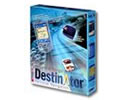'ZDNET Recommends': What exactly does it mean?
ZDNET's recommendations are based on many hours of testing, research, and comparison shopping. We gather data from the best available sources, including vendor and retailer listings as well as other relevant and independent reviews sites. And we pore over customer reviews to find out what matters to real people who already own and use the products and services we’re assessing.
When you click through from our site to a retailer and buy a product or service, we may earn affiliate commissions. This helps support our work, but does not affect what we cover or how, and it does not affect the price you pay. Neither ZDNET nor the author are compensated for these independent reviews. Indeed, we follow strict guidelines that ensure our editorial content is never influenced by advertisers.
ZDNET's editorial team writes on behalf of you, our reader. Our goal is to deliver the most accurate information and the most knowledgeable advice possible in order to help you make smarter buying decisions on tech gear and a wide array of products and services. Our editors thoroughly review and fact-check every article to ensure that our content meets the highest standards. If we have made an error or published misleading information, we will correct or clarify the article. If you see inaccuracies in our content, please report the mistake via this form.
Destinator


Destinator
pros and cons
- Fast destination selection speedy route calculation and recalculation excellent user interface delivers true door-to-door navigation.
- Navigation problems experienced map base has several omissions does not allow calculation of alternative routes.
Destinator, from PowerLOC Technologies, transforms a Pocket PC handheld into a well-featured in-car navigation system. First experiences with Destinator are remarkable: it locks on quickly to accessible GPS satellites to map and display your location on the Pocket PC screen; then you are literally talked to your destination -- corner by corner and roundabout by roundabout. But, as with many first-generation products, a few glitches emerge when it is put through its paces.
Installation & setup
Out of the box you get the installation CD (which also provides the user manual), a 12-channel GPS satellite receiver and a curly coiled lead that connects the receiver both to the Pocket PC and to the cigarette lighter socket to power the GPS receiver and charge the Pocket PC during the journey. A rather flimsy 'pronged' cradle support is supplied to attach the Pocket PC to a dashboard ventilation vent -- a 'stalked' cradle that attaches to the windscreen would be preferable.
Software installation is straightforward: the CD auto-boots in your PC and automatically detects the amount of internal and storage card memory available in the connected Pocket PC. It then automatically suggests suitable locations in the internal and storage card for the Destinator program and the maps of the UK with their embedded location and Points of Interest databases. Destinator uses the Navtech map base, which splits the UK and Ireland into 7 segments -- the Midlands and South-West, South East (including London) Northern England, Northern Ireland, Scotland, Wales and the Irish Republic. Also supplied is a map of the major roads of continental Europe.
During installation you can specify that all maps are loaded into the Pocket PC, or just the set that fits the available space and your journey requirements. The seven directories that comprise the entire map base range in size from 11MB to 44MB -- a full map base installation occupies around 170MB.. For his review we used an IBM Microdrive to provide the external storage. If you use CompactFlash cards as your external storage medium, a realistic minimum capacity is 64MB, into which you'll probably be able to squeeze two adjacent maps, depending on your home location. Destinator works with one map at a time and to specify a destination point you must have the appropriate map loaded (since each map base has its own embedded location and POI database) – even if you have installed the entire map base onto your Pocket PC.
Interface & ease of use
Destinator's user interface for the Pocket PC is well thought-out and easy to learn. Selections are made using soft buttons that are large enough to be activated with a fingertip, allowing some-selections to be made securely while on the move. To plan a journey you start by selecting the Home screen's Destination button and then choose either a city name, a street name or a post code -- whichever is the most convenient. Each successive component of the destination address is tapped out on a soft keyboard. Once you have got down to street level, Destinator lets you further refine the address with the house number -- offering, quite literally, door to door journey planning. Destinator also integrates with the Pocket PC's Pocket Outlook database, allowing you to select a contact and then map the address to specify it as a destination.
Compared with some other Pocket PC-based navigation systems, Destinator offers a very slick, efficient and fast way of specifying destinations. Once your destination has been found in Destinator's database, you can either display a map centered on its location or start planning the route. Route planning is also well implemented and usually completes in an acceptable time (seconds more often than minutes). Destinator's Points of Interest (POI) databases are well integrated: you can specify which POIs to display or search for (restaurants, hotels, conference facilities and specifiable petrol stations such as Shell or Tesco) and then list those nearby and their distances.
As you drive, Destinator's female persona talks you through each route change -- you get an early warning around two miles before a turn or roundabout, followed by a more detailed instruction a couple of hundred yards before, and again when you're about to make the manoeuvre. 'Take the roundabout, third exit', or 'Turn left in 200 yards' are typical instructions. If you don't take Destinator's advice the program will make a few attempts to get you back on track, but then capitulates gracefully by quickly recalculating a new route taking your current position as the start point.
As you travel, Destinator offers two map styles for displaying your position and route: the 'flat' conventional display with your location at the centre and a '3D' display that emphasises the features immediately in front of your car. In practice, we found no advantage in the 3D display and the conventional map was set as the default display.
Performance
We put Destinator through its paces in over 1,500 miles travelling from London to Devon and back and then to the North Midlands. Over this distance, two 'new' roundabouts were 'discovered' and on two other roundabouts the wrong exits were specified. This represents roughly the same level of map base errors we've experienced with similar products. A problem we haven't encountered with other products is that several small villages that figure prominently on OS and Harvey maps -- an example is Hexworthy on Dartmoor -- are not included in the NAVTECH map base. Also, some post codes are omitted from Destinator's database, most notably the E1 '9x' chunk in which ZDNet's UK base is located.
The first indication of problems with Destinator's navigational ability came on a journey from Devon to London, when the program persistently tried to divert off the M4 at junction 17 to continue the journey along the A4 -- despite being instructed to find the quickest route! Destinator also proved incapable of dealing with large roundabouts: an example is the one that links the A50 with the M1. Here, if we'd followed Destinator's spoken instructions, we would have been taken up the northbound M1 instead of southbound. We encountered a similar problem on two other separate occasions where the spoken instructions and the displayed route differed on exiting large roundabouts. On both occasions the spoken directions then expired, leaving the visual display in the driving seat, as it were.
One shortcoming in the Destinator's driving display is that although it indicates the road you are on and the distance to the next manoeuvre, it doesn't give your speed. Instead, there's an optional warning if you're over the speed limit. Unfortunately, this proved to be wrong about the prevailing speed limit more often than it was right: for example, it insisted that long stretches of the M1, M6 and M4 had a 50mph speed limit and frequently imposed a 30 or 40mph limit on unrestricted (60mph) roads. Rather than risk being constantly nagged several times a minute that you are speeding when you are driving perfectly legally, this potentially very useful service was soon turned off.
Destinator has many admirable features. Its user interface is excellent; it operates quickly; you can plan journeys without needing the GPS receiver to be switched on; you can step through routes turn by turn and roundabout by roundabout; and you can also record and playback journeys. However, this is a first-generation product that lacks some of the features seen in second-generation Pocket PC navigators, including the ability to generate alternative routes and to recalculate a route to avoid a road block or to avoid a selected road. Some of the navigation errors we experienced can also be attributed to the software's first-generation status.